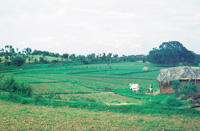Deccan Herald
Grama Chethana, an organisation created by farmers at Surashettikoppa in Dharwad dist and its surrounding villages pass on the secrets of sustainable farming to their counterparts across the State, Anitha Pailoor tells us.

The ultimate goal of farming is not just to grow crops, but to cultivate perfect human beings. Communities around Surashettikoppa in Dharwad try to live up to this goal. Besides equipping themselves with techniques of sustainable farming, they are passing it over to others in the State through hands-on training.
Malleshappa who has received training at Grama Chethana, the organisation formed to train farmers, feels that the hands-on approach and sharing of experience by farmers in Surashettikoppa has inspired him to take the road of sustainability.
Malleshappa was among a team of farmers brought to the organisation for a two-day training programme by Dharwad's Malaprabha Grameen Bank and the NABARD.
A dream come true for farmers in Surashettikoppa and adjacent villages, Grama Chethana has been in action for the past eight months. It's incredible to believe these very farmers didn't have any hopes of survival 10 years ago and started migrating to cities. "Thanks to the guidance by BAIF, Dharwad, we could achieve the unthinkable," says Mr Haklada.
Under the project 'Transfer of technology for sustainable development', Dharwad division of BAIF Institute for Rural Development imparted its training programme in 1996 at 22 villages of Kalaghatagi and Hubli. Intended to alleviate poverty among indigent families, the project became a roaring success due to full co-operation by the farmers.
"Though the project came to a close on March 2005, we wanted to continue with the programme. After much brainstorming, we came up with the concept of Grama Chethana," says Dr Prakash Bhat, additional programme director, BAIF. The idea was concretised after consultations with Sarvodaya Mahasangha (federation of self-help groups).
The concept was eventually realised with contributions from Gram Vikas Samithi and other farmers associations. The Mahasangha's purchase of one-acre land at Surashettikoppa made local farmers take responsibility for the project. "Our objective of greater public participation happened in this project voluntarily," Dr Bhat notes.
Basavanneppa Angady, former president of Sarvodaya Mahasangha mentions training programme offered at Grama Chethana is different: "We carry on with what BAIF taught us.
If a farmer comes to buy 100 teak saplings from our nursery, we brief him about other trees that can be planted and widen his options. This information often turns out to be helpful for him," he adds.
Manjunath, the BAIF staff who co-ordinates workshops at the centre, says farmers handle sessions quite effectively, as they talk from their own experience. This gradually led to increase in number of visitors to the farms here and so arose the need to conduct the training in an organised way through a centre.
Areas handled here also covered livestock, tree-based farming, soil and water conservation, sericulture and people's organisation.
A rightful blend of classroom and practical sessions, the programme offers farmers the unique opportunity of living through what they learn, in the aspect of farming they choose. Arun Kumar of Yellapur, another member of the NABARD sponsored team, says that he could see how things worked in Surashettikoppa.
"Initially it appeared quite normal. The sight of farmers handling indoor sessions however, made us feel the difference slowly and during our field visits, we witnessed the way farmers integrated agriculture into their lifestyle and how it has improved their standard of living," Arun Kumar explains.
Armed with technical information, resource persons explain how the techniques transformed their lives - and inspired other farmers to follow them in their own farms. Bharamavva Hosamani, one of the nine resource persons handling the five categories of training, says talking about his experience became easier, as he started handling more batches.
"After all, we are going to talk about what we have gone through and the two-day indoor-session-cum-field-visit is adequate to do that," Hosamani says. Even the building, where the centre is housed, is designed to suit the objectives of environmental friendliness. Bharamagoudra Ninganagoudra Patil and his wife act as caretakers of the centre.
Dr Bhat says that by earning their livelihood from the centre-owned land, the Patils have indeed become examples for Grama Chethana's objectives and a role model for other farmers.
1 comment:
Nice Information Sir and find the Best Home Nursing Services in Hubli
Post a Comment